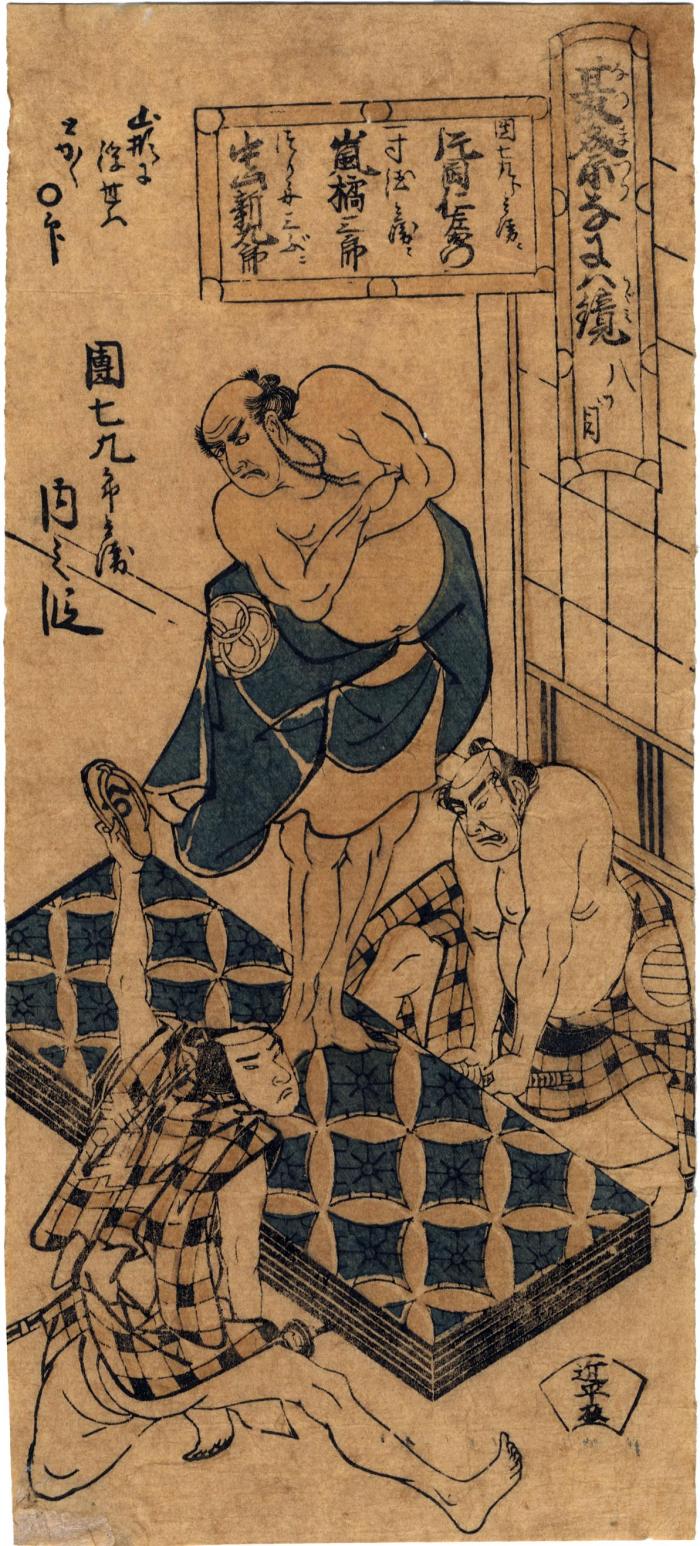Anonymous / unknown (artist )
Kataoka Nizaemon VII (片岡仁左衛門) as Danshichi Kurobei (團七九郎兵衛), Arashi Kitsusaburō II (嵐橘三郎) as Issun Tokubei (一寸徳兵衛) and Nakayama Shinkūrō III or IV (中山新九郎) as Tsurifune no Sabu (つり船ノ三ふ) from the scene 'At Tsurifune Sabu's home'
1820s
5.875 in x 13 in (Overall dimensions) Japanese woodblock print with color applied through stencil
Unsigned
Publisher, probably: Kinpei han (近平板)
Ritsumeikan University This image portrays a scene from the play Natsu matsuri Naniwa kagami ('Mirror of the summer festival in Osaka: 夏祭浪花鑑). The scene is called "Tsuribune Sabu Uchi" ('At Tsuribune Sabu's home': 釣船三婦内). "It depicts the moment when Tsuribune no Sabu uses a folding screen (byôbu) to separate Danshichi from his attacker, Issun Tokubei. Here, Sabu is standing on the screen, trapping the adversaries' swords underneath the frame."
We would especially like to thank John Fiorillo for his generous help in determining the subject matter along with the names of the actors and their roles. He also provided the name of the publisher and type of print this is.
****
Originally this print was attributed to Ryūkōsai Jokei (流光斎如圭), as per information provided by the seller. But John Fiorillo pointed out: "The design is not by Ryûkôsai. The style is more like Nagahide or an artist working in a similar manner. It is not 18th century. Andreas Marks indicates that Nagahide prints from this publisher were circa 1825. Perhaps your print, regardless of the artist, is circa 1820s."
****
Do you have to be a linguistics expert to study Japanese prints?
No... just as long as you keep some things in mind while doing research. Linguists struggle mightily to give the closest sound in their own language to that of the sound they are hearing in a completely different language. However, that is not always the easiest thing to do. Sometimes their transliterations have shades of difference that can lead researcher down the wrong path, or, at least, an alternate path. Therefore, let me point out a few things that are not always obvious to students and collectors about Japanese words and names. For example, the name 'Tsuribune no Sabu' can also be transcribed as 'Tsurifune no Sabu' or just plain 'Tsurifune/Tsuribune Sabu'. For whatever reason, the sound of some Japanese words can be read, and thus heard, as a 'b' or an 'f'. In other cases, the sound for a 'b' can also be heard as an 'm'. 'M' and 'n' are often interchangeable. And, there are quite a few other examples. That is why, when you are doing research on a name such as Tsuribune no Sabu, you might want to also look it up as Tsurifune no Sabu, or some such variation.
A slight change in spellings and hence pronunciations in Western languages can suddenly open doors to you that might otherwise be kept hidden. We hope that this explanation can help others doing such research... or it might just leave them scratching their heads in wonderment. All we are saying is that transliterations are not set in stone and will often benefit the researcher who does a little tweaking of a sound/spelling.
actor prints (yakusha-e - 役者絵) (genre)
Kyōto-Osaka prints (kamigata-e - 上方絵) (genre)
Kataoka Nizaemon VII (七代目片岡仁左衛門: 2/1788 to 3/1837) (actor)
Arashi Kitsusaburō II 二代目嵐橘三郎 (9/1822 to 8/1828) (actor)
kappazuri-e (合羽摺絵 stencil print) (genre)
Danshichi Kurobei (団七九郎兵衛) (role)
